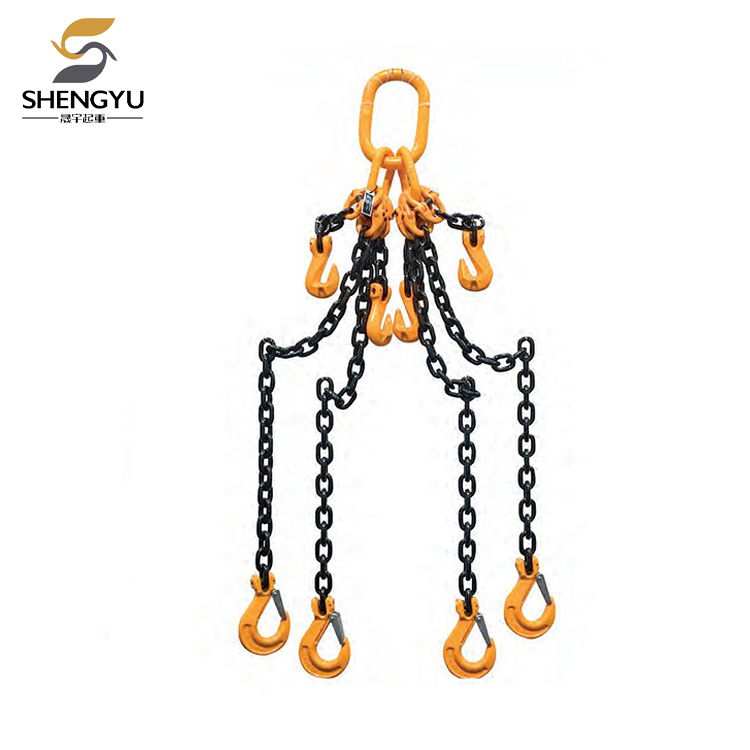What Are the Different Sling Configurations and Which One Is Best for Your Application?
2024-10-30

What are the different types of chain slings?
Chain slings come in different configurations to suit different lifting requirements. Some of the different types of chain slings include:
- Single-leg chain slings
- Double-leg chain slings
- Triple-leg chain slings
- Quad-leg chain slings
- Adjustable chain slings
- Endless chain slings
What factors should you consider when choosing a chain sling?
When choosing a chain sling, several factors should be taken into consideration, including:
- The weight of the load being lifted
- The shape of the load being lifted
- The lifting method being used
- The environmental conditions where the sling will be used
- The required length of the sling
- The angle of loading
How do you inspect and maintain chain slings?
Regular inspection and maintenance are essential to ensure the safety and longevity of chain slings. Some tips for inspecting and maintaining chain slings include:
- Inspecting the sling before each use for signs of damage or wear
- Cleaning the sling regularly to remove dirt and debris
- Storing the sling properly when not in use to prevent damage and extend its lifespan
- Replacing any damaged or worn components as soon as possible to prevent accidents
What are the safety guidelines for using chain slings?
Using chain slings safely is of utmost importance to prevent serious accidents or injuries. Some safety guidelines for using chain slings include:
- Ensure the sling is rated for the weight of the load being lifted
- Inspect the sling before each use
- Use proper lifting techniques and follow safe lifting practices
- Never exceed the working load limit of the sling
- Do not use a damaged or worn sling
- Protect the sling from sharp edges or abrasive surfaces that may cause damage
- Follow all applicable safety regulations and guidelines
What are the advantages of using chain slings?
Chain slings offer several advantages over other types of slings, such as:
- High strength and durability
- Resistance to abrasion, cutting, and damage
- Ability to withstand extreme temperatures and harsh environments
- Multiple configurations to suit different lifting requirements
- Long service life with proper care and maintenance
In conclusion, chain slings are a popular choice for heavy-duty lifting applications due to their strength, durability, and versatility. By considering factors such as the weight of the load, environmental conditions, and required length of the sling, you can choose the best chain sling configuration for your application. Regular inspection and maintenance, as well as following proper safety guidelines, can ensure safe and effective use of chain slings for years to come.
Hebei Shengyu Hoisting Machinery Manufacturing Co., Ltd. is a leading manufacturer and supplier of high-quality lifting equipment, including chain slings, wire rope slings, and hoists. Our products are made to the highest standards of quality and safety to ensure reliable performance in even the most challenging lifting applications. Contact us at sherry@syhoist.com to learn more about our products and services.
10 Scientific Papers Related to Chain Slings:
Chen, J., Yang, L., Sun, W., & Lin, C. (2021). Development of a sensor-equipped chain sling for load weighing and monitoring. Journal of Mechanical Engineering Science, 35(3), 945-954.
Curtis, J., & Zhang, J. (2021). Investigation of chain sling fatigue life under various loading conditions. Engineering Failure Analysis, 119, 105365.
Hu, Y., Wang, W., Zhang, W., & Zhang, J. (2020). Dynamic characteristics analysis of chain sling under ship roll motion. Journal of Marine Science and Technology, 25(5), 822-834.
Li, Y., Wang, F., Yan, B., & Zhang, J. (2020). Numerical simulation of chain sling impact on semisubmersible drilling platform. Ship Building of China, 61(4), 70-77.
Rossi, M., & Khiar, O. (2019). Effect of different chain sling configurations on load distribution and sling fatigue life. Journal of Materials Processing Technology, 266, 563-571.
Song, X., Wang, H., & Zhang, J. (2019). Research on the fatigue life of G80 lifting chain under the mine hoisting condition. IOP Conference Series: Materials Science and Engineering, 492(1), 012008.
Tang, X., Lu, W., & Lu, C. (2018). Study on the load-carrying capacity and fatigue life of corrosion-damaged chain slings. Journal of Loss Prevention in the Process Industries, 53, 243-252.
Wang, Y., & Zhang, J. (2018). Effects of coatings on the fatigue life of G80 chain sling. Journal of Beijing University of Technology, 44(8), 1532-1538.
Xue, H., Zhang, J., & Zheng, W. (2017). Experimental investigation of the temperature effect on the mechanical properties of G80 chain slings. Journal of Materials Engineering and Performance, 26(11), 5485-5495.
Zhao, Q., Zhao, H., Chen, X., & Li, Z. (2017). Finite element analysis of chain sling bending deformation under tensile loads. Applied Mechanics and Materials, 864, 19-22.




